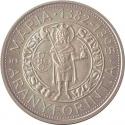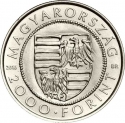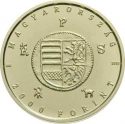You are about to finish your registration. Please check your mailbox (including spam folder). There should be a letter with a confirmation link. Check setting to make sure that your e-mail address is correct.
Send letter againDescription
Gold coinage has a longstanding history in Hungary, dating back to the early days of the Hungarian kingdom. The first known gold coin was a solidus minted during the reign of the kingdom's inaugural ruler, St. Stephen (997-1038), which is exceptionally scarce today. Subsequently, over 300 years passed before another gold coin emerged, struck during the reign of the first monarch from the House of Anjou, King Charles (or Karl) Robert (1301-1342). While this coin occasionally surfaces in collectors' markets today, fetching thousands of dollars, it serves as the prototype for the inaugural release in an annual series of Hungarian gold coins titled "The Gold Florins of Medieval Hungary." The newly issued legal tender 10,000 Forint coin faithfully replicates both sides of Charles I's Gold Florin, supplemented with the king's name and reign dates.
Engraver: Tamás E. Soltra
Obverse

|
Depicts the reverse design of Charles I Robert's Gold Florin, showcasing Saint John the Baptist standing. The top inscription reads "Charles I," while the bottom text indicates his birth and death years, "1301–1342." Adorning the space between the top and bottom inscriptions are decorative motifs depicting the Angevin lily on both the left and right sides. Additionally, positioned below the motif on the right side is the engraver's privy mark. + I. KÁROLY + |
|---|---|
Reverse

|
Depicts the obverse design of Charles I Robert's Gold Florin, showcasing the fleur de lis motif, recognized as the fiorino d’oro (also the origin of the Hungarian word “forint”). The top inscription reads "HUNGARY," while the bottom inscription, separated by a dot, indicates the denomination and "FORINT." Positioned between these inscriptions, the year of issue "2012" is displayed on the left side, while the mintmark "BP." is situated on the right side. MAGYARORSZÁG |
| Edge |
10 000 Forint
Gold Florins of Medieval Hungary
Gold Florin of Charles I Robert
Subscribe series
KM# 841 Adamo# EM249
Gold Florins of Medieval Hungary
Gold Florin of Charles I Robert
Related coins
Gold Florins of Medieval Hungary
Gold Florins of Medieval Hungary







